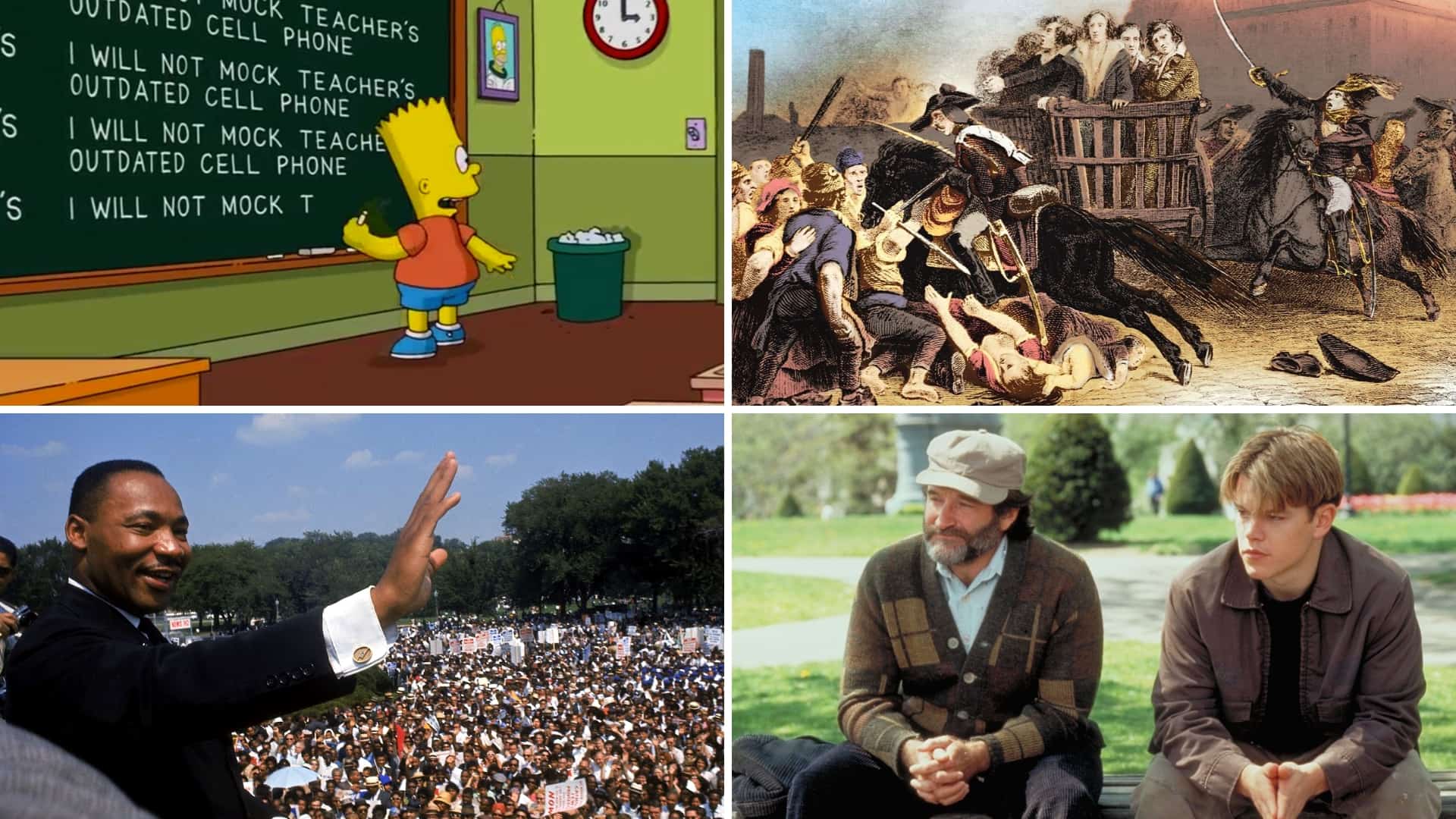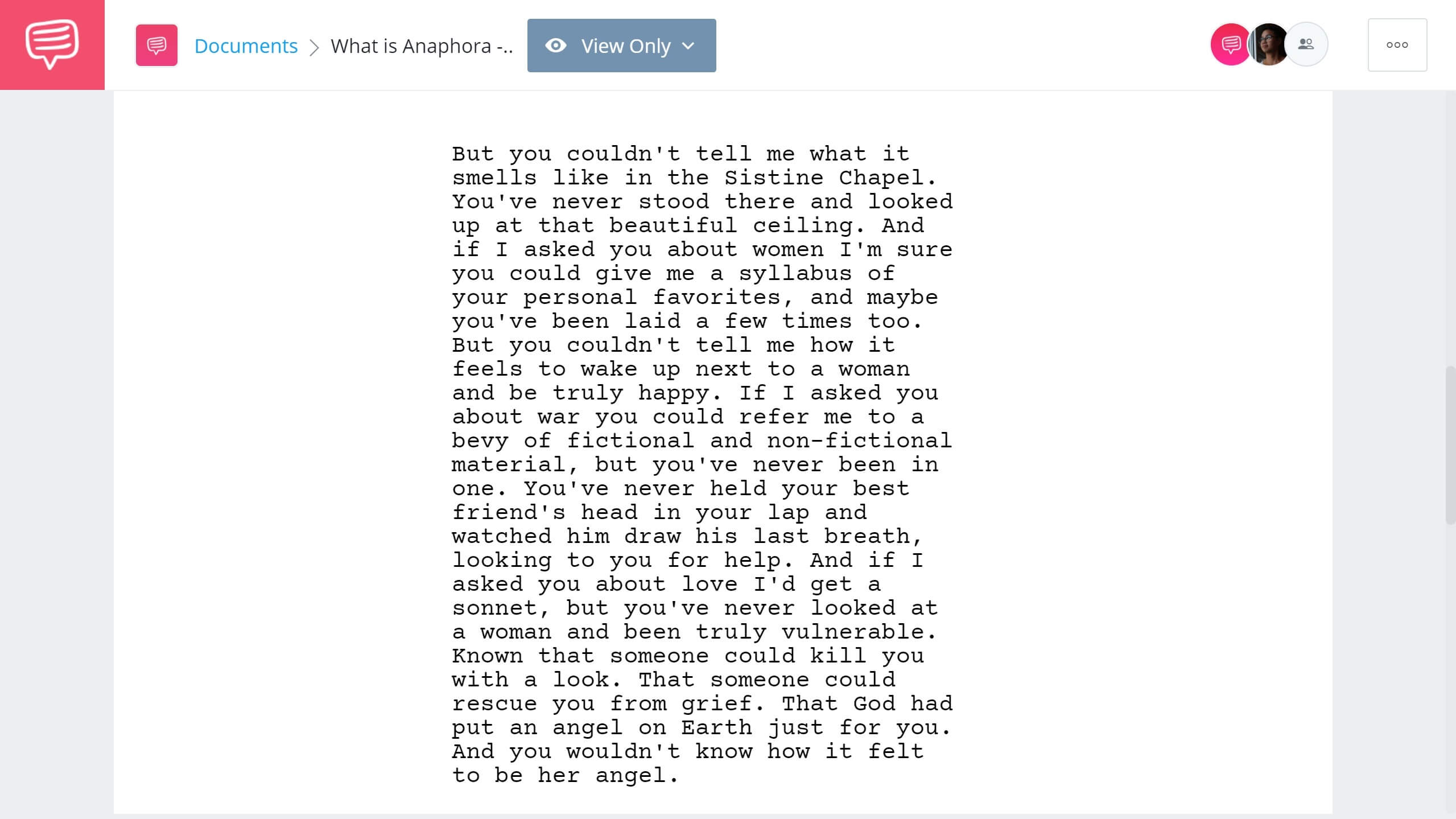Anaphora can be iconic. Anaphora can be memorable. Anaphora can be effective. Okay, that may be a terrible example of the effectiveness of anaphora. Nevertheless, anaphora is responsible for some of the most iconic speeches in history. What is anaphora and how does it accomplish all of these things? In this article, we’ll take a look at the definition and examine uses of it in history, literature and film.
what is anaphora?
First, let’s define anaphora
Anaphora is not an extremely recognizable literary device. However, it appears more often in daily conversation and written text more than you think. To identify it more easily, let’s take a look at the anaphora definition.
ANAPHORA DEFINITION
What is anaphora?
Anaphora is the repetition of a word or group of words at the beginning of successive clauses or sentences. Anaphora is commonly used in literature and speeches to drive home a point, message, or idea through repetition. Anaphora adds rhythm to a phrase or sequence of phases thus making it more memorable. The word anaphora comes from Greek meaning a “carrying back.” Today it is used in speeches, literature, and screenwriting to make dialogue or sentences more memorable and effective.
What is anaphora used for?
- Creating rhythm
- To compare and contrast multiple ideas
- Making phrases or sentences more memorable
define anaphora
Why do writers use anaphora?
The use of anaphora is most commonly used for emphasizing a specific idea or message. The use of repetition in anaphora makes specific words stick in the mind’s or the reader or audience.
Anaphora also allows the writer to compare and contrast different ideas by linking them to the same beginning sequence of words. By using anaphora, writers invite the audience or reader to compare various ideas to one another.
Lastly, anaphora can give a body of text rhythm. The repetition of a phrase can give a speech a pace that motivates the audience to follow along and listen further to the message being said.
All of these reasons also make speeches or writing more memorable. The repetitive nature of anaphora makes specific words and ideas stick in the minds of the audience. To better understand how anaphora makes a piece of writing more engaging and memorable, let’s take a look at some of history’s most iconic speeches and how they became iconic through the use of anaphora.
Related Posts
list of anaphora examples
Anaphora in speeches
On August 28th, 1963, Martin Luther King Jr. delivered what became one of the most iconic speeches in American history. To call for civil and economic rights for African Americans and for an end to racism, Martin Luther King Jr. described his dreams using anaphora to drive home his point.
“I have a dream that one day this nation will rise up and live out the true meaning of its creed: 'We hold these truths to be self-evident, that all men are created equal.'
I have a dream that one day on the red hills of Georgia, the sons of former slaves and the sons of former slave owners will be able to sit down together at the table of brotherhood.
I have a dream that one day even the state of Mississippi, a state sweltering with the heat of injustice, sweltering with the heat of oppression, will be transformed into an oasis of freedom and justice.
I have a dream that my four little children will one day live in a nation where they will not be judged by the color of their skin but by the content of their character.
I have a dream today!”
The repetitive use of the phrase “I have a dream” is perhaps the most iconic use of anaphora in history. It drives home the deep desire and urgency for justice and freedom in America and has made the speech one of the memorable speeches in American history.
examples of anaphora in art
Anaphora in literature
In the historical novel A Tale of Two Cities, Charles Dickens utilizes anaphora to create a memorable opening paragraph. The juxtaposition of using opposite ideas all linked by the phrase “It was” encourages the reader to better understand the world and times that the novel is taking place in.
“It was the best of times, it was the worst of times, it was the age of wisdom, it was the age of foolishness, it was the epoch of belief, it was the epoch of incredulity, it was the season of Light, it was the season of Darkness, it was the spring of hope, it was the winter of despair.”
The use of anaphora in the opening paragraph also creates an immediate pace and rhythm. It briskly opens the door for the reader into the world of the novel. The use of anaphora in the opening paragraph also comes full circle when Dickens uses it again in the closing sentence of the novel.
“It is a far, far better thing that I do, than I have ever done; it is a far, far better rest I go to than I have ever known.”
Dickens uses anaphora poetically, giving the beginning and end of his novel a sense of musicality. Novelists, however, are not the only type of writers that benefit from the use of anaphora. Screenwriters also use anaphora to create iconic dialogue and monologues.
Related Posts
how to use anaphora in movies?
Anaphora in screenwriting
In their Good Will Hunting screenplay, Matt Damon and Ben Affleck wrote an incredibly moving monologue. The monologue, written for Robin William’s character Sean, had to be effective and emotional enough to break through to the hardened Will Hunting (Damon).
They use anaphora of the phrase “If I asked you” throughout the monologue to emphasize the point that Will thinks he knows the answers to every question thrown at him. Sean is able to break through with this monologue, by telling Will there are things he doesn’t know because of lack in life experiences.
We brought the Good Will Hunting screenplay into the StudioBinder screenwriting app to analyze how the use of anaphora made this monologue so memorable. Click the script image to read the entire speech and get the full effect of how good this writing actually is.
Anaphora Example in Good Will Hunting • Read Full Scene
Sean’s monologue uses anaphora of the phrase “If I asked you” and always follows it by a phrase starting with “You’ve never” or “You wouldn’t." Not only does this allow Sean to break through to Will, but it also introduces one of the film’s themes to the audience.
To see how anaphora makes this monologue emotionally impactful, let’s take a look at how this scene plays out on screen.
Good Will Hunting • 'Your Move Chief'
Watching and listening to the monologue also shows anaphora can create rhythm and pace in a rather long monologue. This helps the audience stay engaged with the monologue despite its length.
Related Posts
UP NEXT
Explore more literary devices
Anaphora is just one of many literary devices and types of figurative language, including alliteration, assonance, and repetition. If you're a writer and want to develop your craft fully, do yourself a favor and continue this exploration. The next article on literary devices is a gateway to many of these tools that help add substance and style to any type of written work.

